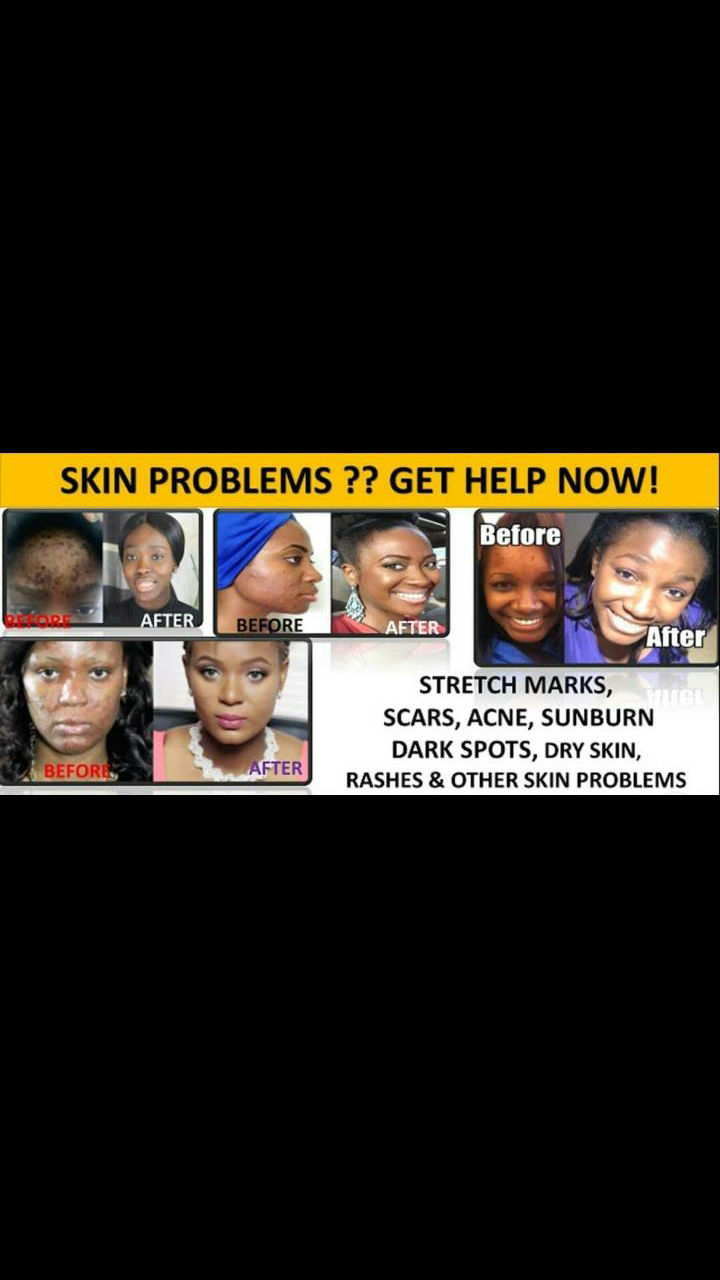YOUR SKIN AND STRETCH MARKS
YOUR SKIN AND STRETCH MARKS
Stretch marks are long, narrow streaks, stripes or
lines that develop on the skin and which differ in hue from the surrounding skin.
They are the result of a sudden stretching of the skin and are extremely common.
Anyone can develop stretch marks, although they tend to affect more women than men.
Stretch marks can be visible on body parts including the tummy, thighs, hips, breasts, upper arms, and lower back. The marks form in the middle layer of the skin; when there is a constant stretch, the layer tears, leaving stretch marks.
This type of scarring happens when the skin cannot bounce back after a period of intense growth, be that due to pregnancy, weight gain, or during puberty. Extreme weight loss can also make stretch marks more visible, and some stretch marks arise as a result of acute trauma affecting the skin (such as a car accident when heavily pregnant).
Stretch marks are usually a slightly red or purple shade to begin with, fading with time to silvery white lines that may or may
What are stretch marks?
Stretch marks are also called striae distensae, SD, striae, striae atrophicans and striae gravidarum. They are dermal scars or disfiguring lesions characterized by flattening and atrophy (wasting or degeneration) of the epidermis (the outermost layer of the skin).
Stretch marks are linear, smooth bands on the skin that, depending on skin color, can appear as red or purple and which fade over time to leave silvery pale marks.
Stretch marks are long, narrow streaks that are visible on the surface of the skin as a result of sudden stretching of the skin.
 Occurring in 40-90% of women, stretch marks appear following rapid repeated over-stretching of the skin over weak connective tissue. The most common areas affected are the:
Occurring in 40-90% of women, stretch marks appear following rapid repeated over-stretching of the skin over weak connective tissue. The most common areas affected are the:
Abdomen
- Breasts
- Hips
- Flank
- Buttocks
- Thighs.
Skin changes are common in pregnancy with stretch marks occurring in over 70% of pregnant women, usually after 25 weeks of gestation.
Stretch marks are not medically dangerous, but can be a cause of aesthetic concern and anxiety. For some people, stretch marks are such a significant cosmetic concern that they affect quality of life. They can be disfiguring, causing emotional and psychological distress, especially during puberty, the latter stages of pregnancy (when they are most prominent), in the postnatal period where they appear pale, or after significant weight loss.
This type of dermatological scarring is particularly challenging and tends to occur with
- Pregnancy
- Puberty
- Obesity
- Rapid weight gain
- Weightlifting
- Numerous medical conditions
- Certain therapeutic interventions.
Pregnancy
Stretch marks are common during the later stages of pregnancy; their occurrence depends largely on
skin type and skin elasticity.
Preliminary research in women undergoing a second Caesarian section has revealed that the greater the severity of stretch marks in pregnancy the more likely it is that intraperitoneal adhesions are present, which may complicate the second C-section or other abdominal surgery.
Intraperitoneal adhesions were present in half of those with severe striae gravidarum, 30% of those with mild stretch marks, and fewer than 1 in 10 (9.1%) of those with no stretch marks.
Hormones are produced during pregnancy that soften pelvic ligaments and increase their flexibility. Hormones also soften skin fibers, giving an increased risk of stretch marks.
Stretch marks appear on the abdomen as the baby grows and sometimes occur in the skin covering the thighs and breasts.
Puberty

Rapid weight gain(Obesity)

Stretch marks may also arise if a person gains weight rapidly, such as when bodybuilders and athletes dramatically increase muscle mass over a short period of time.
Medical conditions
Medical conditions such as Cushing's syndrome and Marfan syndrome can lead to the development of stretch marks. Marfan syndrome is a genetic condition that causes weakness and decreased elasticity in body tissues.
 Cushing's syndrome can cause stretch marks because the condition involves the overproduction of cortisol (the stress hormone), which can lead to rapid weight gain, especially in the abdomen, in addition to causing the skin to become fragile, thin and more susceptible to bruises, scarring and infection. Cushing's syndrome is three times more common in women than in men, but can be successfully treated in most cases.
Cushing's syndrome can cause stretch marks because the condition involves the overproduction of cortisol (the stress hormone), which can lead to rapid weight gain, especially in the abdomen, in addition to causing the skin to become fragile, thin and more susceptible to bruises, scarring and infection. Cushing's syndrome is three times more common in women than in men, but can be successfully treated in most cases.
Ehlers-Danlos syndrome (EDS) is a rare inherited condition that disrupts the integrity of structural proteins in the skin which can also cause stretch marks.
Corticosteroids

Sometimes prolonged or inappropriate use of corticosteroid creams and lotions that are used to treat eczema can cause stretch marks by decreasing collagen levels and thinning the skin.
Late-stage faded stretch marks are a type of scar characterized by a loss of collagen. This key structural protein is found throughout the body, providing strength and cushioning to many different areas, including the skin - and elastic fibers in the dermis. The dermis is the sensitive layer of skin below the epidermis, containing nerve endings, sweat and sebaceous glands, and blood and lymph vessels.
What causes stretch marks?
 The skin consists of three key layers: epidermis (the outer layer), dermis (the middle layer) and subcutaneous or hypodermis (the deepest layer). Stretch marks form in the dermis when the connective tissue is "stretched" beyond the limits of its elasticity due to rapid expansion or contraction of the skin from sudden growth or weight gain.
The skin consists of three key layers: epidermis (the outer layer), dermis (the middle layer) and subcutaneous or hypodermis (the deepest layer). Stretch marks form in the dermis when the connective tissue is "stretched" beyond the limits of its elasticity due to rapid expansion or contraction of the skin from sudden growth or weight gain.The three main layers of the skin are the epidermis, dermis and hypodermis. Stretch marks are caused when the dermis is stretched so rapidly it tears.
The abrupt stretching causes the dermis to tear which allows deeper skin layers to show through, forming the stretch marks.
Usually, as the body grows, the strong connecting fibers in the dermis slowly stretch. However, with rapid growth, the fibers overstretch and break. Stretch marks are red or purple initially due to blood vessels showing through the tears in the dermis.
Stretch marks eventually fade to a silvery, white or glossy appearance due to the blood vessels contracting and the pale fat underneath the skin becoming visible instead.
Stretch marks are more likely to develop and to appear more extreme where there are high levels of circulating cortisone, or where cortisone is used topically. Cortisol, the stress hormone produced by the adrenal glands is converted into cortisone, which weakens elastic fibers in the skin.57
A number of risk factors have been associated with the development of stretch marks but the evidence supporting these associations is highly variable. Much remains to be understood about the etiology, diagnosis and treatment of stretch marks.
The pathogenesis of stretch marks is unknown but is likely to relate to changes in the fibroblast phenotype.
A study that compared skin biopsies from volunteers with normal skin (NS), and both stretch-mark skin (SM) and normal-looking skin (NL) from patients with stretch marks found that:
- There was less DNA, protein, and elastin in the skin of people with stretch marks compared to the skin of those without stretch marks, with those deficiencies more profound in SM skin.
- Cells derived from NL and SM skin had slower than normal outgrowth of their fibroblasts, demonstrating low migration and proliferation rates, and producing less elastin, fibrillin 1, collagen 1, and fibronectin than cells derived from NS.
The skin structure of stretch marks is qualitatively and quantitatively different compared to healthy skin. The altered appearance of the skin reflects structural modifications in the dermis.
A series of tests led to the discovery of a dormant phenotype in dermal fibroblasts from patients with stretch marks. These tests may help predict a predisposition to stretch marks and could open up a new approach for preventive treatments for people predisposed to stretch mark formation.
The cause and associated factors for stretch mark occurrence could be linked to:

It has been shown that women with a higher BMI have an increased risk of stretch marks.
- Maternal age
- Hormone changes
- Genetic factors
- Inherited defects
- Pre-pregnancy BMI
- Maternal BMI at delivery
- Gestational age at delivery
- Birth weight of the baby
- Alcohol consumption
- Water intake
- Family history
- Physical stretching of the skin.
Women with a higher body mass index (BMI) have more stretch marks, except in cases where stretch marks are related to breast augmentation, in which case a low or normal BMI increases the likelihood of stretch marks. They are more frequently observed in younger women, with teenagers suffering the most severe stretch marks.
These findings may be explained by the greater degrees of stretch applied to the skin in obese women with larger babies, and by changes in skin collagen and connective tissue that are age-related and which affect its likelihood of tearing.
One study suggests that increased maternal age could be a protecting factor against stretch marks during pregnancy.
It has been suggested that genetics may play a role in the development of stretch marks. Regardless of the etiology, all stretch marks display the same changes in the dermis, showing atrophy and loss of rete ridges (rete ridges are the downward projections of the epidermis that interlock with the papillary or superficial dermis). These findings are similar to those seen with scar formation.
Research has also indicated that areas of skin that undergo greater mechanical stretching may respond differently to hormonal signals from estrogens, androgens and glucocorticoids. This is because under such conditions the skin cells appear to express greater hormonal receptor activity. In fact, in one small study involving eight people with stretch marks and eight without, estrogen receptors were twice as concentrated in the skin of those with stretch marks.
PLEASE CLICK ON THIS LINK FOR RECOMMENDED PRODUCTS FOR SCARS AND
STRETCH MARKS. PRODUCTS FOR SCARS AND STRETCH MARKS








































No comments
Post a Comment